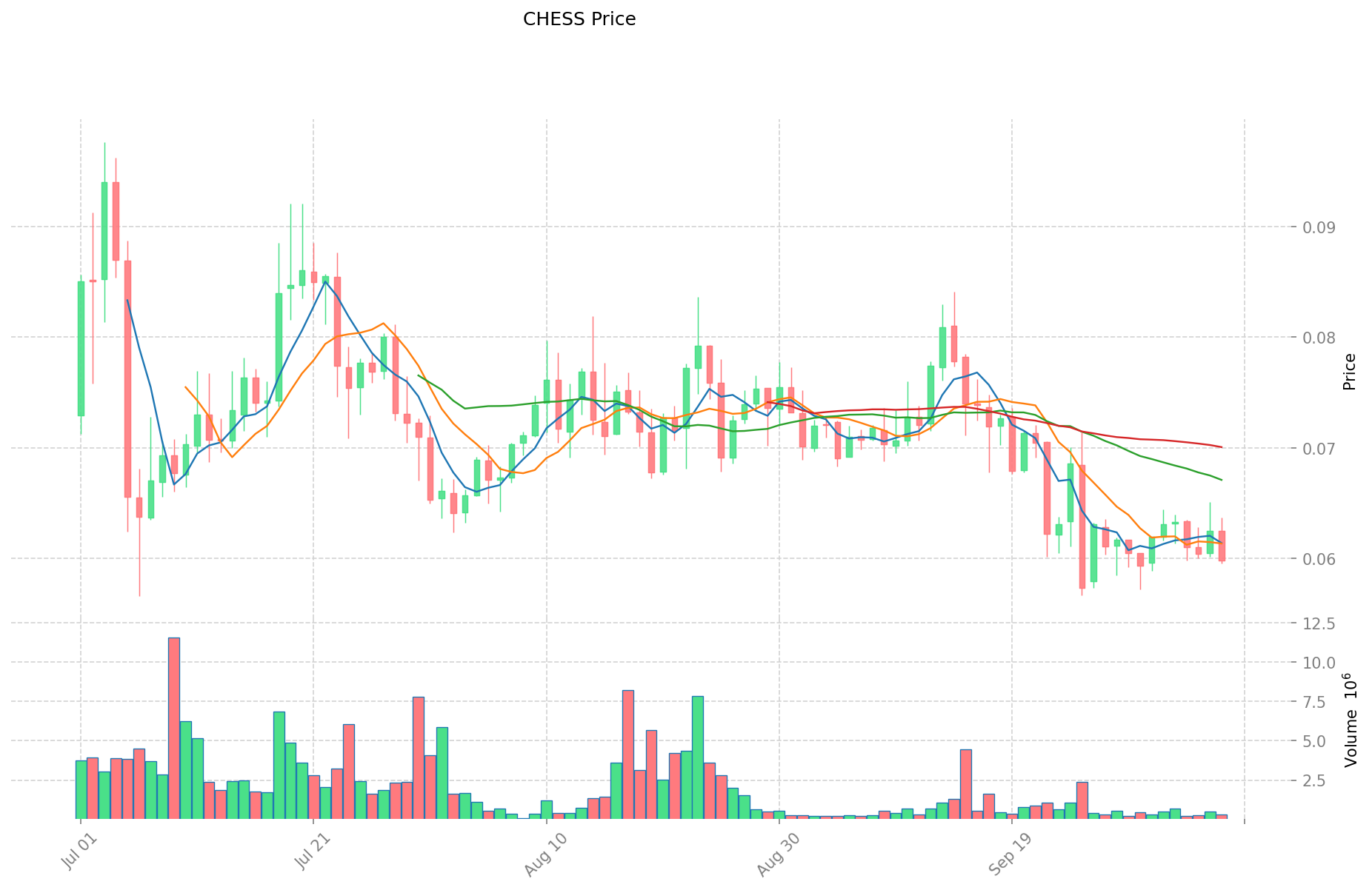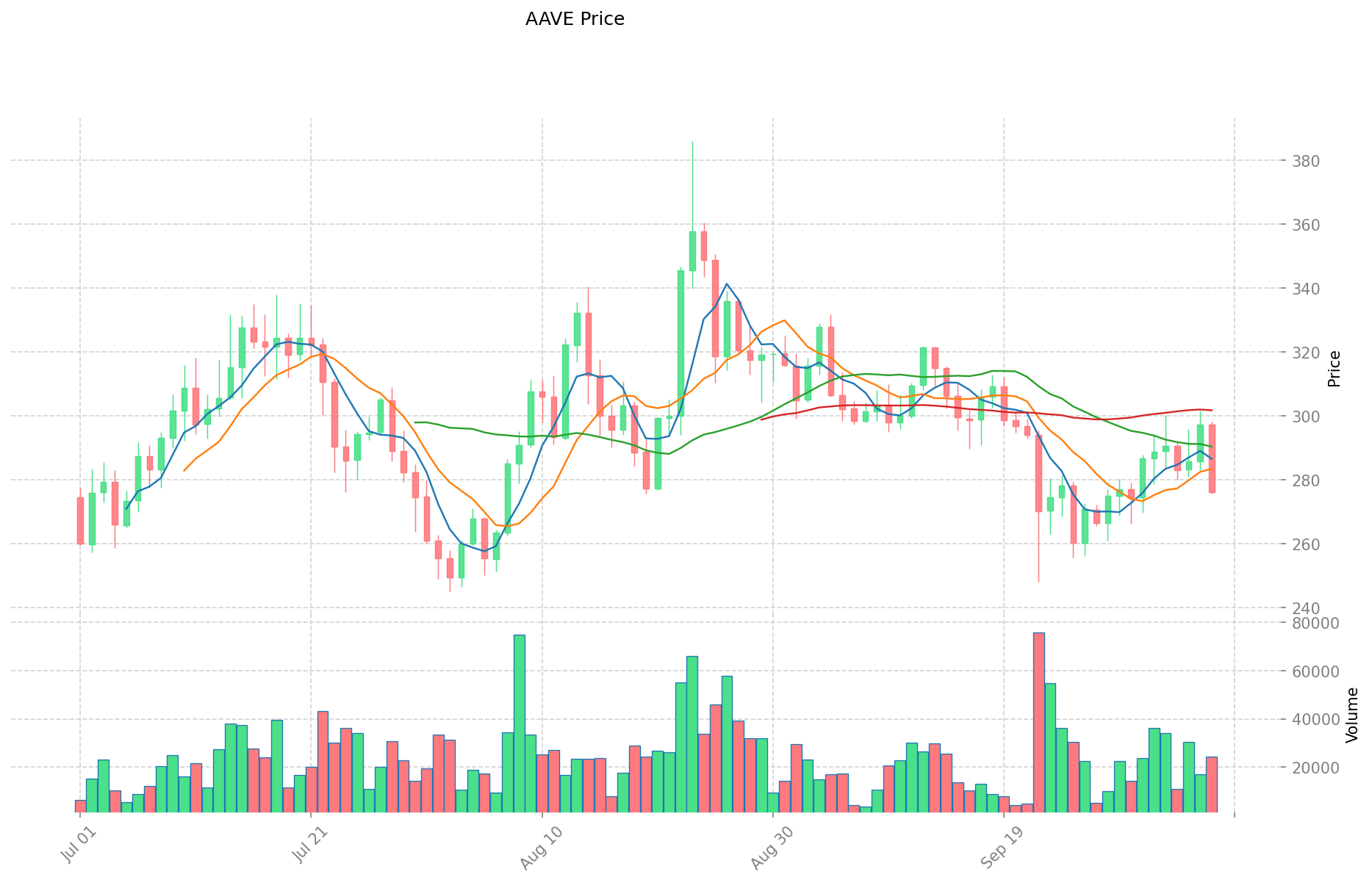CHESS vs AAVE: Comparing Two DeFi Lending Protocols in the Evolving Cryptocurrency Ecosystem
Introduction: Investment Comparison between CHESS and AAVE
In the cryptocurrency market, the comparison between CHESS vs AAVE has always been a topic that investors cannot ignore. The two not only have significant differences in market cap ranking, application scenarios, and price performance, but also represent different crypto asset positioning.
CHESS (CHESS): Since its launch in 2021, it has gained market recognition for its tokenized asset management and derivatives trading protocol.
AAVE (AAVE): Since its inception in 2020, it has been hailed as a leading decentralized lending protocol, and is one of the cryptocurrencies with the highest global trading volume and market capitalization.
This article will comprehensively analyze the investment value comparison between CHESS vs AAVE, focusing on historical price trends, supply mechanisms, institutional adoption, technological ecosystems, and future predictions, and attempt to answer the question most concerning investors:
"Which is the better buy right now?"
I. Price History Comparison and Current Market Status
CHESS (Coin A) and AAVE (Coin B) Historical Price Trends
- 2021: CHESS reached its all-time high of $7.91 due to the DeFi boom.
- 2020: AAVE was rebranded from LEND and saw significant price appreciation as DeFi gained traction.
- Comparative analysis: During the 2022 bear market, CHESS dropped from its high of $7.91 to a low of $0.04, while AAVE showed more resilience, maintaining a higher price level.
Current Market Situation (2025-10-08)
- CHESS current price: $0.05986
- AAVE current price: $276.41
- 24-hour trading volume: $19,076.75 (CHESS) vs $6,907,908.25 (AAVE)
- Market Sentiment Index (Fear & Greed Index): 70 (Greed)
Click to view real-time prices:
- Check CHESS current price Market Price
- Check AAVE current price Market Price


II. Core Factors Affecting CHESS vs AAVE Investment Value
Supply Mechanisms Comparison (Tokenomics)
- CHESS: Structured into risk-based tranches allowing investors to choose different risk-reward profiles
- AAVE: Lending protocol token with governance utility in the DeFi ecosystem
- 📌 Historical Pattern: Supply mechanisms create different investment opportunities based on risk appetite, with CHESS offering structured options and AAVE focusing on DeFi utility.
Institutional Adoption and Market Applications
- Institutional Holdings: Limited information available in the provided data
- Enterprise Adoption: CHESS offers structured fund design with Turbo & Stable modes catering to different investor risk preferences, while AAVE's adoption information is not specified in the data
- Regulatory Attitudes: Not specifically detailed in the provided information
Technical Development and Ecosystem Building
- CHESS Technical Development: Features STONE fund operating mechanism with different risk segments that can be separated or combined according to investor preferences
- AAVE Technical Development: Not specifically detailed in the provided information
- Ecosystem Comparison: CHESS focuses on providing diversified investment options through structured fund design, with high-risk components using leverage for higher returns and low-risk components offering more controlled, stable returns
Macroeconomic and Market Cycles
- Market Sentiment: Investor sentiment directly impacts price movements, with positive news about widespread adoption or major technical breakthroughs influencing market direction
- Risk Factors: Cryptocurrency market volatility creates both opportunities for value increases and substantial risks, forcing investors to identify tokens less likely to suddenly lose value
- Investment Strategy Considerations: Capital volume becoming a core factor in recent crypto activities, with recommendations for focused quality account interactions rather than broad transaction volume strategies
III. 2025-2030 Price Prediction: CHESS vs AAVE
Short-term Prediction (2025)
- CHESS: Conservative $0.0526 - $0.0598 | Optimistic $0.0598 - $0.0760
- AAVE: Conservative $188.20 - $276.77 | Optimistic $276.77 - $376.41
Mid-term Prediction (2027)
- CHESS may enter a growth phase, with an estimated price range of $0.0727 - $0.0908
- AAVE may enter a consolidation phase, with an estimated price range of $242.20 - $430.57
- Key drivers: Institutional capital inflow, ETF, ecosystem development
Long-term Prediction (2030)
- CHESS: Base scenario $0.1007 - $0.1370 | Optimistic scenario $0.1370 - $0.1500
- AAVE: Base scenario $556.74 - $829.54 | Optimistic scenario $829.54 - $1000.00
Disclaimer: This analysis is based on historical data and market projections. Cryptocurrency markets are highly volatile and unpredictable. This information should not be considered as financial advice. Always conduct your own research before making investment decisions.
CHESS:
| 年份 | 预测最高价 | 预测平均价格 | 预测最低价 | 涨跌幅 |
|---|---|---|---|---|
| 2025 | 0.0759714 | 0.05982 | 0.0526416 | 0 |
| 2026 | 0.083511711 | 0.0678957 | 0.057032388 | 13 |
| 2027 | 0.0908444466 | 0.0757037055 | 0.07267555728 | 26 |
| 2028 | 0.0874377798525 | 0.08327407605 | 0.0424697787855 | 39 |
| 2029 | 0.1160840620137 | 0.08535592795125 | 0.0819416908332 | 42 |
| 2030 | 0.136979193176166 | 0.100719994982475 | 0.058417597089835 | 68 |
AAVE:
| 年份 | 预测最高价 | 预测平均价格 | 预测最低价 | 涨跌幅 |
|---|---|---|---|---|
| 2025 | 376.4072 | 276.77 | 188.2036 | 0 |
| 2026 | 346.183916 | 326.5886 | 244.94145 | 18 |
| 2027 | 430.57441024 | 336.386258 | 242.19810576 | 21 |
| 2028 | 552.2116811328 | 383.48033412 | 222.4185937896 | 38 |
| 2029 | 645.627490524432 | 467.8460076264 | 364.919885948592 | 69 |
| 2030 | 829.53775612236984 | 556.736749075416 | 417.552561806562 | 101 |
IV. Investment Strategy Comparison: CHESS vs AAVE
Long-term vs Short-term Investment Strategies
- CHESS: Suitable for investors focused on structured finance and diversified risk profiles
- AAVE: Suitable for investors interested in DeFi lending and governance participation
Risk Management and Asset Allocation
- Conservative investors: CHESS: 30% vs AAVE: 70%
- Aggressive investors: CHESS: 60% vs AAVE: 40%
- Hedging tools: Stablecoin allocation, options, cross-currency portfolios
V. Potential Risk Comparison
Market Risks
- CHESS: Higher volatility due to smaller market cap and lower liquidity
- AAVE: Exposure to broader DeFi market fluctuations
Technical Risks
- CHESS: Scalability, network stability of the structured finance platform
- AAVE: Smart contract vulnerabilities, liquidity risks in the lending protocol
Regulatory Risks
- Global regulatory policies may impact both differently, with DeFi protocols like AAVE potentially facing more scrutiny
VI. Conclusion: Which Is the Better Buy?
📌 Investment Value Summary:
- CHESS advantages: Structured risk-based investment options, potential for high growth
- AAVE advantages: Established DeFi lending platform, larger market cap, higher liquidity
✅ Investment Advice:
- New investors: Consider AAVE for its established position and lower volatility
- Experienced investors: Explore CHESS for its structured finance opportunities and growth potential
- Institutional investors: Diversify between both, with a larger allocation to AAVE for stability
⚠️ Risk Warning: The cryptocurrency market is highly volatile. This article does not constitute investment advice. None
VII. FAQ
Q1: What are the main differences between CHESS and AAVE? A: CHESS is a tokenized asset management protocol offering structured risk-based investment options, while AAVE is a leading decentralized lending protocol in the DeFi ecosystem. CHESS has a smaller market cap and higher volatility, while AAVE has a larger market cap and higher liquidity.
Q2: Which coin has performed better historically? A: AAVE has shown more resilience in price performance, especially during the 2022 bear market. While CHESS reached an all-time high of $7.91 in 2021, it dropped significantly to $0.04, whereas AAVE maintained a higher price level.
Q3: What are the current prices and trading volumes of CHESS and AAVE? A: As of 2025-10-08, CHESS is priced at $0.05986 with a 24-hour trading volume of $19,076.75. AAVE is priced at $276.41 with a 24-hour trading volume of $6,907,908.25.
Q4: How do the supply mechanisms of CHESS and AAVE differ? A: CHESS is structured into risk-based tranches, allowing investors to choose different risk-reward profiles. AAVE, on the other hand, is a lending protocol token with governance utility in the DeFi ecosystem.
Q5: What are the long-term price predictions for CHESS and AAVE? A: By 2030, the base scenario for CHESS is predicted to be $0.1007 - $0.1370, with an optimistic scenario of $0.1370 - $0.1500. For AAVE, the base scenario is $556.74 - $829.54, with an optimistic scenario of $829.54 - $1000.00.
Q6: How should investors allocate their assets between CHESS and AAVE? A: Conservative investors might consider allocating 30% to CHESS and 70% to AAVE, while aggressive investors might allocate 60% to CHESS and 40% to AAVE. However, individual allocations should be based on personal risk tolerance and investment goals.
Q7: What are the main risks associated with investing in CHESS and AAVE? A: CHESS faces higher volatility due to its smaller market cap and lower liquidity, as well as potential technical risks related to its structured finance platform. AAVE is exposed to broader DeFi market fluctuations and potential smart contract vulnerabilities. Both may face regulatory risks, with DeFi protocols like AAVE potentially facing more scrutiny.
Share
Content